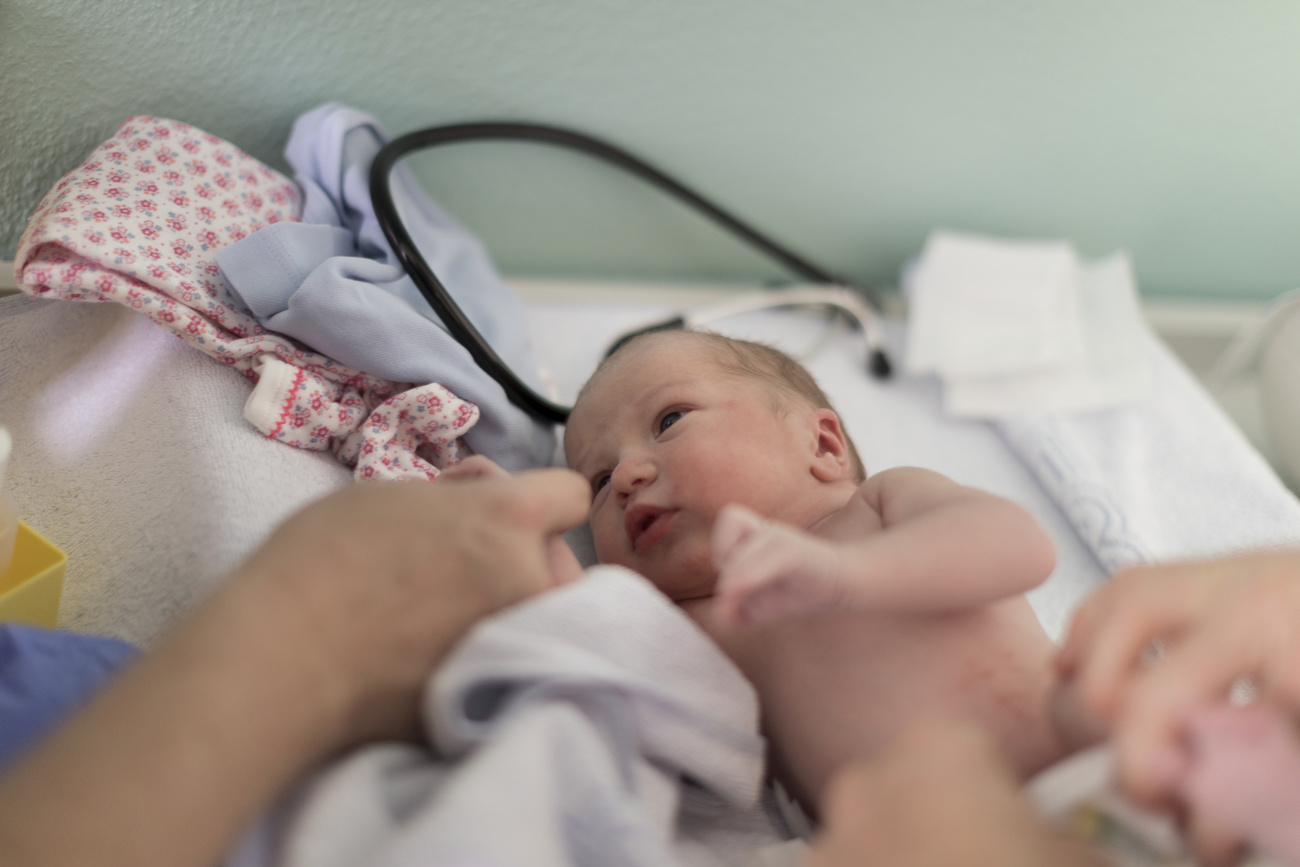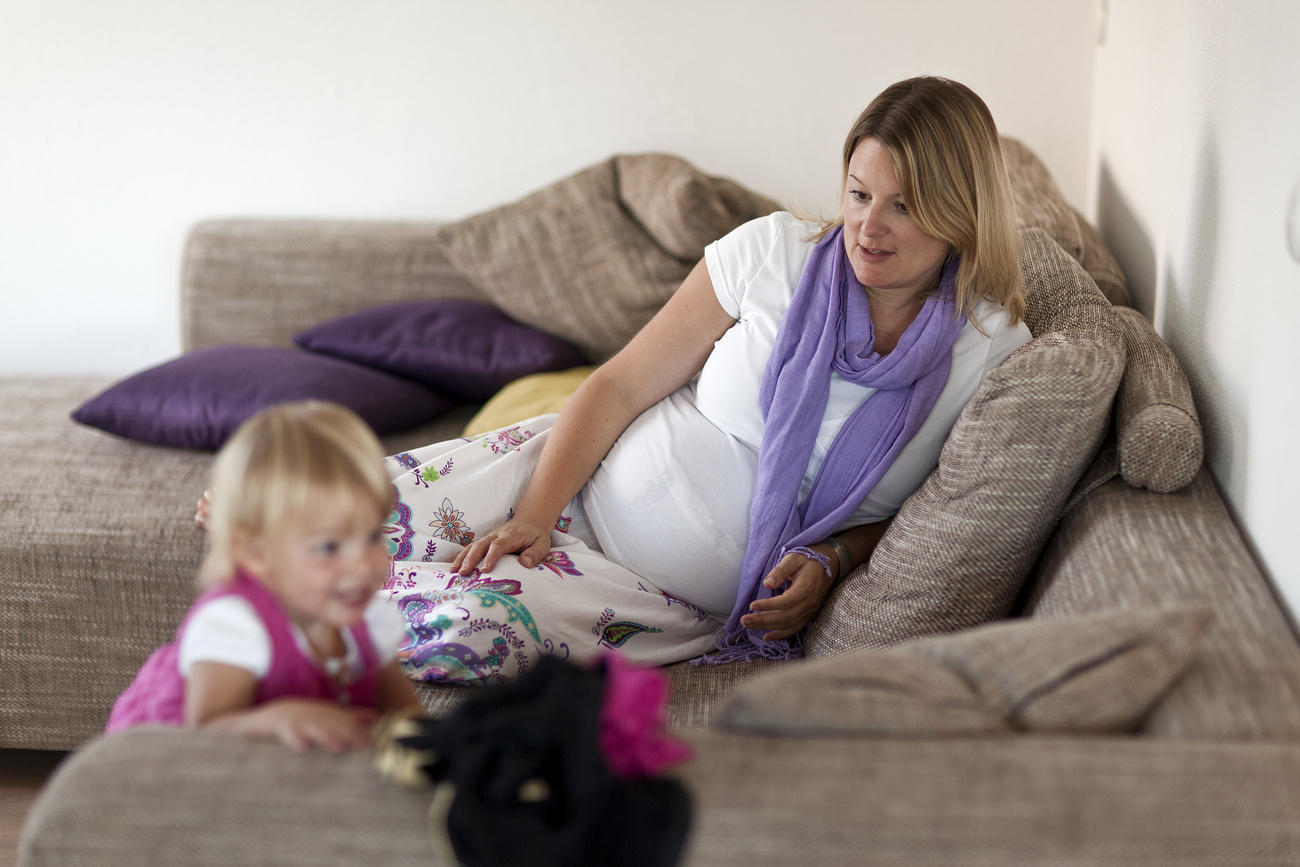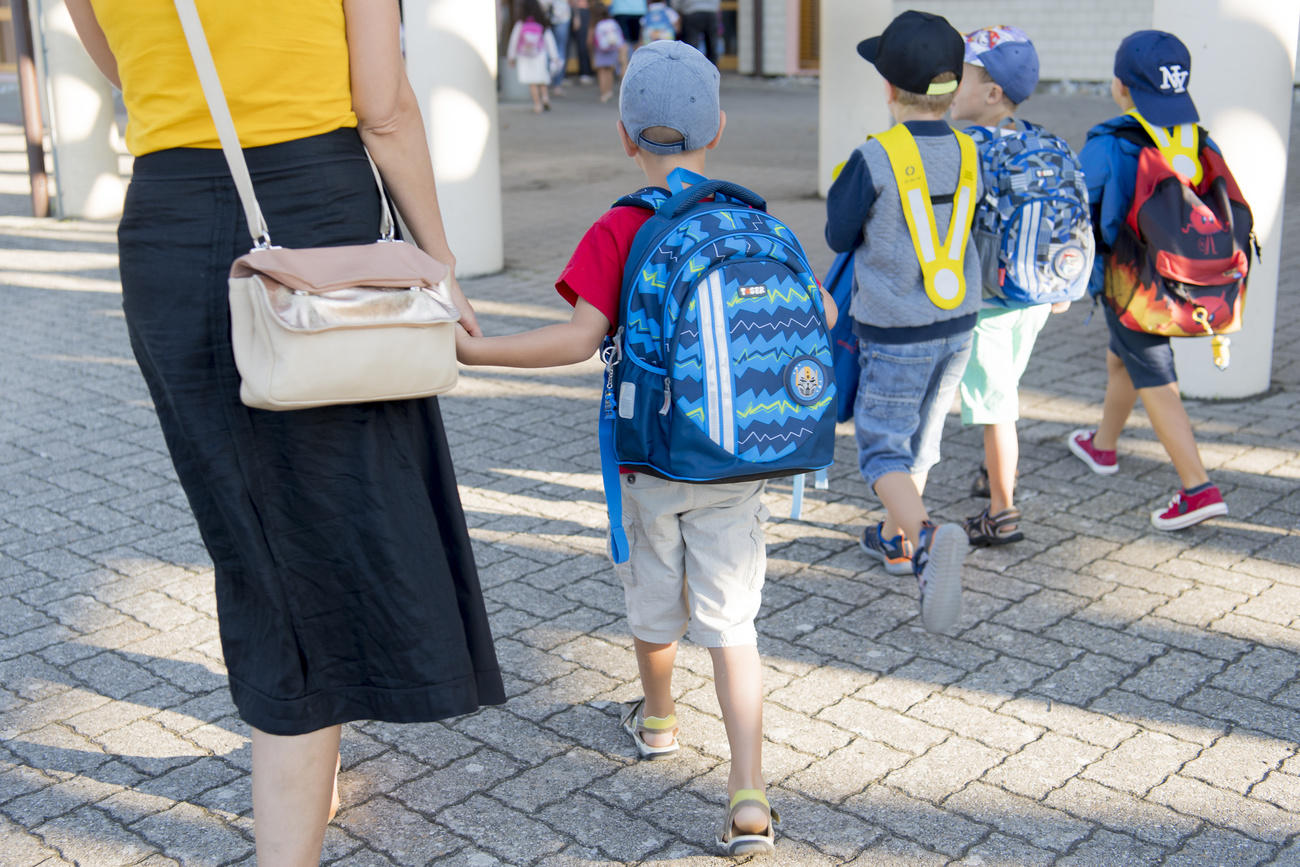
Fertility rates plummet in Switzerland – and beyond

The global fertility decline has not spared Switzerland. Some states are trying to boost births with publicity campaigns or baby bonuses. But it will take a lot more to change the choices being made by today’s couples.
In Switzerland, one rarely encounters a family with three or four children now. Like many developed economies, this country has fallen below the threshold needed to maintain existing population numbers (2.1 children per woman) since the early 1970s.
Yet figures published last year by the Swiss Federal Statistical Office are strikingExternal link. In 2022, the birth rate fell below 1.4, the lowest level since 2001. All this in spite of the fact that at least twoExternal link children remains the ideal for nine out of ten people.
The same trend can be observed across the globe. After decades that saw the size of families shrink – a demographic shift spurred by better education and jobs for women, availability of contraception and urbanisation – many countries are now witnessing a free fall in births.
East Asia now has the lowest birth rate (0.8 children per woman in South Korea, 1.2 in China, 1.3 in Japan). In Western Europe, Italy and Spain are the countries where women now have the fewest children, less than 1.3 on average.
This decline also affects IrelandExternal link and FranceExternal link, which used to be the main bastions of fertility in Europe, but also Nordic countriesExternal link, long regarded as a paradise for families due to their generous parenting policies.
North America, the most developed Latin American countries, and Australia are similarly affected.
Only in sub-Saharan Africa, where large families remain a valued resource, is the birth rate still high – though it has been declining in the past 30 years. In coming decades, it is in Africa that world population will increase the most. By 2050, Africa should be the most populous continent.
The burden of parenthood
Decline in births, especially in the developed countries, is due to a range of factors. Tomas SobotkaExternal link, deputy director of the Vienna Institute of Demography, points first to socio-economic barriers such as the cost of housing and child-minding services, insecurity of employment and the stagnation of incomes.
Parenthood is no longer the automatic choice it once was “in a world which an increasing number of young adults perceive as hostile”, he says. If and when couples decide to take the plunge, it is often in their mid-to-late thirties, when the biological clock is ticking away.
In Switzerland, for example, where raising two offspring to adulthood is thought to cost at least CHF500,000 ($567,390), the economically “rational choice” is to refrain from reproducing, in the words of an economist quoted in a recent Neue Zürcher Zeitung opinionExternal link piece.

More
In Switzerland, having a child is becoming a luxury
The opening up of the workplace means new career ambitions that are hard to reconcile with having kids. Even the place of children in society has changed, according to Philippe WannerExternal link, professor at the Institute of Demography and Socioeconomic Studies in Geneva. “For a long time considered a value, children today are considered a burden,” he told SWI swissinfo.ch.
More
Inverted age pyramid
The fact that fewer children are being born has to do with new opportunities in life, especially for women, and a waning of the model of the “ideal” family.
For a society, a low birth rate may not be bad news at all in the short term, because it means more resources are freed up to provide for the health and education of everyone. It also means more available adults – available to be productive, that is.
But in the long term, the demographic scenario that is emerging is worrisome. The age pyramid is starting to invert. The ageing of the population will gather steam over the coming decades, causing manpower scarcities and knocking the social insurance system off balance.
Some countries like Switzerland have put off the problem by allowing immigration. Yet immigration as a permanent solution is a political gamble, and it may not work in the long term.

More
Demographic shifts cause Swiss labour market crunch
Apart from economic considerations, there is the basic existential question. The French daily Le MondeExternal link recently asked: “Isn’t a world without children really a dead world?”, while attempting to draw political attention to the collapse of the birth rate.
‘Demographic rearmament’
Given this apocalyptic outlook, governments have been casting about for attention-getting solutions, with a goal of boosting their populations. In January, French president Emmanuel Macron announced he was going to “rearm France demographicallyExternal link” with a new parental leave programme and a plan to combat infertility.
Some countries like South KoreaExternal link, Greece and HungaryExternal link have even gone further, offering special allowances to young parents, interest-free loans, or even land grants. One Finnish municipality created a stir in 2018 by offering a bonus of €10,000 (CHF9,526) for every child born and raised there.
Elsewhere, governments have tried appealing to people’s patriotism or at least their sense of humour with publicity campaigns (as in ItalyExternal link and DenmarkExternal link).
In countries with authoritarian regimes, reproductive rights are coming to be seen as a problem. After abandoning its one-child policy in 2015 and allowing couples to have two, China has raised the bar to three children. Iran and RussiaExternal link, in the meantime, are taking a critical attitude to abortion.
There is nothing like this going on in liberal Switzerland. Valais parliamentarian Jean-Luc Addor of the right-wing People’s Party suggested “tax incentives for a real policy to boost populationExternal link” in 2021 but his motion got nowhere. The former health minister, Alain Berset, said at the time that the government was opposed to “a family policy aimed at boosting birth rates, as it seems hardly compatible with freedom of choice in starting a family.”
More than a baby bonus needed
Isolated political stratagems do not influence the decision to have a child, demographers point out. At best, they encourage people already intending to increase their family size. Government appeals to have children are more likely to fall on deaf ears.
All these approaches have little chance of being effective unless they are part of an overall policy on the family. This would mean an ecosystem favorable to families, with its supports being financial aid, child-minding infrastructure and parental leave.
Committed to boosting population since 1950, France is one of the most active countries on this front. France is the OECD country with the highest public expenditure on family allowances. This distinction stems from family allowances, which are progressive depending on family size, according to professor Wanner.
The Nordic countries are often thought of as models because they offer generous parental leave, infrastructure for inexpensive childcare, and also because “fathers are very much a part of things”, notes Sobotka.
He also mentions Germany, which has given a right to a childcare place to all children over one year of age (there have been difficulties implementing thisExternal link), and Estonia, where the shared parental leave programme of 600 days “is one of the most flexible”.
Compared to such bold initiatives, family policy in Switzerland is limited. “The family allowance is too low to have an impact,” thinks Wanner, and “society is not much taken with the idea of balancing roles.” Crèche places are the most expensive in the OECDExternal link and there are not enough of them.
In the Swiss federal system, many aspects of family policy are decided at local level. There are sometimes political initiatives on the table, such as bringing in a parental leave that can be taken either by the father or mother, along with guaranteed access to nurseriesExternal link, but the lack of consensus means they go nowhere.
This means that in Switzerland, “people regard as important successes what would count as minor progress anywhere else”, says Wanner, quoting the example of the maternity leave of 14 weeks introduced in 2005.

More
Swiss government takes childcare in hand
Fewer and fewer babies
Nevertheless, the impact of family policies on the birth rate is marginal. In Europe, their purpose is mainly to make life easier for families. Demographers estimate that they increase the birth rate by 0.2 children per woman at the most. “That’s not nothing but it really doesn’t change the overall situation,” admits Sobotka, who heads a European research group on fertility and the family.
Business could play a major role here, if employers offered greater flexibility to parents as they try to juggle careers and family. That might involve remote working, annualisation of working hours, free choice for workers in determining their percentage of full-time work, being able to stop working for a time without being penalised, or making their own discretionary use of shared parental leave, according to demography experts.
In Switzerland, such options are rare, “because many businesses here are SMEs which don’t have the means,” notes Wanner. The few firms offering childcare, or more generous parental leave than the minimum required by law, are multinationals.
Ideally, it would be necessary to rethink the whole role of parents and children in society to get to a different dynamic. “That’s the hardest thing to do,” points out Sobotka, “for that would mean change not only at the political level, but also in thinking and social attitudes.”
So things won’t change anytime soon. An “era of low fertility” has begun, concludes the demographer. In coming decades, birth rates still high today will fall, and remain low everywhere else, according to projectionsExternal link from the United Nations, so that “in future, the only nations to stand out will be those with extremely low fertility.”
In the UN’s scenario, most regions will see their balance of population become negative in the near future – within this coming decade in Europe. With more deaths than births, specialists expect the world’s population to go down by the end of the century.
Edited by Marc Leutenegger and Samuel Jaberg; adapted from French by Terence MacNamee/ds

In compliance with the JTI standards
More: SWI swissinfo.ch certified by the Journalism Trust Initiative










































You can find an overview of ongoing debates with our journalists here . Please join us!
If you want to start a conversation about a topic raised in this article or want to report factual errors, email us at english@swissinfo.ch.